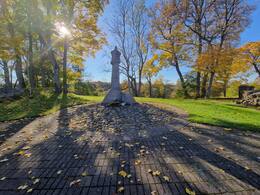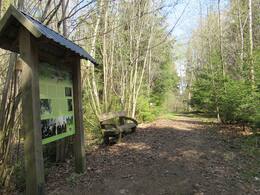The Battle of Seda: A Story of Flight and Death
The 1944 battles near Seda experienced not only heroic moments, but also episodes of panicked running, when soldiers, seeing the impending threat of defeat, tried to save their lives.
"I saw people running, stumbling, not getting up and leaving. I was among those fighting, dying and fleeing. I was one of the first to run. I wanted nothing else and there was no other thought in me - just to run away," - Albinas Vaitkus, a participant in the battles, later becoming the famous writer in exile Marius Katiliškis, openly describes his experience. The irony of fate was that the poet Vytautas Macernis, who did not participate in the battles themselves, became a victim of the battle, while Katiliškis managed to escape alive and well.
Related timeline
Related topics
Related objects
Monument to those killed in the Battle of Seda
The monument to those who died in the Battle of Seda stands in the town of Seda itself, next to the Church of the Assumption of the Blessed Virgin Mary. This monument was unveiled on August 1, 1999. The author of the monument is sculptor Osvaldas Neniškis. The monument is dedicated to the memory of the soldiers of the Homeland Defense Team who died in the Battle of Seda on October 7, 1944.
The Battle of Seda was an armed clash between units of the Lithuanian Homeland Defense Forces and the Soviet Army that took place on October 7, 1944.
In the first half of 1944, the German occupation authorities in Lithuania abolished the Local Unit led by General Povilas Plechavičius, but as the situation at the front deteriorated, it had to take into account the Lithuanians' desire to create independent military units to fight the advancing Soviet army. In July, all Lithuanian combat units operating in Viekšniai parish and Mažeikiai county were merged into the so-called Homeland Protection Unit, which was subordinate to the German army. It was to defend the front line near Seda, as the USSR army advanced in the direction of Klaipėda.
As autumn approached, Seda was prepared for a circular defense: the majority of the Homeland Security Forces were deployed to the east and north of Seda, with one incomplete battalion near Barstyčiai, on the western side.
The units of the USSR army, which began the Klaipėda operation, reached the Seda area in early October 1944. On the morning of October 7, several dozen Soviet tanks attacked the approaches to Seda, defended by the Homeland Defense Team, followed by a rifle division. The battles for Seda were fought only in July, when about 6,000 volunteers, including 112 officers, 5 of whom had the rank of colonel, gathered into a military unit called the Homeland Defense Team.
The location of the battles is not marked, but you can visit the monument dedicated to those who died in the Battle of Seda.
Vytautas Mačernis Birthplace Trail
In the village of Šarnelė, Plungė district, in the birthplace of the Lithuanian poet Vytautas Mačernis, a path to the poet's birthplace has been established. Walking along this 545 m long path, you will reach the poet's grave. The poet died on October 7, 1944, during the Battle of Seda, when he was accidentally hit in the head by a fragment of an artillery shell. After his death, the poet's relatives returned the deceased back to Šarnelė to be buried in his homeland.
While walking along the V. Mačernis hiking trail, don't miss the nearby Kerpauskas spring and information stand. This spring commemorates an important historical period - the genocide of the Jewish people during World War II. The Kerpauskas spring is located by the path leading from the parking lot to the poet's grave. During World War II, the family of Juozas and Adolfina Kerpauskas hid Jews in underground bunkers installed at the foot of a small hill near the spring and in the homestead below. For three and a half years, the family took care of several Jewish families - 16 people in total - and protected them from destruction. During the Soviet era, Adolfina and Juozas Kerpauskas and their children Bronė and Tomas were deported to Siberia. Juozas Kerpauskas in 1992 and Adolfina Kerpauskienė in 2009 were awarded the Salvation Cross.






